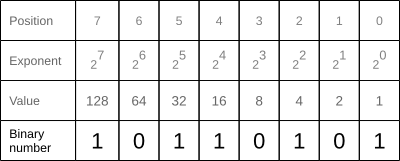
When 1 is divided by 2, the quotient is 0 and the remainder is 1.When 2 is divided by 2, the quotient is 1 and the remainder is 0.When 5 is divided by 2, the quotient is 2 and the remainder is 1.When 10 is divided by 2, the quotient is 5 and the remainder is 0.When 21 is divided by 2, the quotient is 10 and the remainder is 1.When 42 is divided by 2, the quotient is 21 and the remainder is 0.When 85 is divided by 2, the quotient is 42 and the remainder is 1.This utility also allows you to customize the binary number format – you can add padding of any length and append a binary prefix or suffix to the output number.8 5 2 4 2 1 2 2 1 0 2 1 0 1 2 5 0 2 2 1 2 1 0 2 0 1 Remainders We named it the human method because it makes it easy to distinguish between positive and negative binary numbers. The last method is a bonus method as it doesn't change the binary value in any way and only adds a minus '-' sign before negative binaries. Yet another encoding method is base minus two, also known as the negabinary method, which decomposes a number into a sum of powers of -2. If you keep counting up, you'll also find 93, which is 11011101b, and 127, which will be all one-bits 11111111b. In this case, it's 7 because (-2) 7 is -128. If you want to find -93, then you first find the smallest n, such that this number fits in (-2) n. In excess code, the number (-2) n is defined to be 0b and it can represent numbers from (-2) n to 2 n-1. It uses a novel approach to encode negatives. Another representation method is biased binary, also known as excess (offset) binary code. The number becomes 10100011b, which is -93. To get -93 from 93, which is 01011101b, we first find its bitwise-not, which is 10100010b, and then add one.

What this means is first we flip all bits in the number and then increment the number by one. In two's complement, a negative number is add-one its bitwise not.

This method is the dominant encoding scheme in computer hardware as it's easier to perform mathematical operations with it. The third encoding method is two's complement. For example, if we have the number 93, which is 01011101b in binary, then after bitwise not this number becomes 10100010b, which is negative -93. This operation replaces all zeros with ones and all ones with zeros. The positive numbers in this method are the same as in the sign bit method but the negative numbers are created by applying the bitwise not operation to positive numbers. The second method of representation is one's complement. As you can see, the first bit is flipped from 0 to 1 and that also flips the sign of the number. For example, 01011101b is a positive number because the first bit is '0' and the remaining bits are 1011101b, which is equal to 93 in decimal, therefore this number is +93. The remaining bits show the absolute value of the number. You can think of '0' as '+' and '1' as '-'. If the number is negative, then the leftmost bit is set to '1'. If the integer is positive, then the leftmost bit is set to '0'. In this method, the most significant bit (leftmost bit) is used as the sign of the number. It's the simplest way to encode a signed integer to binary. We have implemented five different signed number representations. Therefore, negative numbers in binary are represented in special binary schemes that encode the minus sign to a bit pattern. The binary number system has only two symbols '0' and '1', and unlike the decimal number system, there is no negative sign '-'. This tool converts negative decimal numbers (and also positive) to the binary numeral system.


 0 kommentar(er)
0 kommentar(er)
